Coffee Husks Valorization for Levoglucosan Production and Other Pyrolytic Products through Thermochemical Conversion by Fast Pyrolysis
Abstract
1. Introduction
2. Materials and Methods
2.1. Coffee Husks Biomass Collection and Characterization
2.2. Experimental Procedures
2.2.1. Coffee Husks Biomass Acid Pretreatments
2.2.2. Fast Pyrolysis of Coffee Husks Biomass
2.3. Analytical Methods
2.3.1. Coffee Husk Characterization
2.3.2. Elemental Analysis (CHN-O)
2.3.3. FTIR Spectroscopy Analysis
2.3.4. Scanning Electron Microscopy (SEM) Analysis
2.4. Principal Component Analysis
3. Results and Discussion
3.1. Compositional Analysis of Untreated Biomass
3.2. Coffee Husk Pretreatment Prior Pyrolysis
3.3. Fast Pyrolysis of Coffee Husks
3.3.1. Levoglucosan Production
3.3.2. Oxygenated Compounds Production
3.3.3. Phenolic Compounds Production
4. Conclusions
Author Contributions
Funding
Data Availability Statement
Acknowledgments
Conflicts of Interest
Appendix A
| Variables | Study Cases | ||||||||||||
|---|---|---|---|---|---|---|---|---|---|---|---|---|---|
| 1 | 2 | 3 | 4 | 5 | 6 | 7 | 8 | 9 | 10 | 11 | 12 | ||
| Nº | Name | Untreated 400 °C | Untreated 500 °C | Untreated 600 °C | Acetic Acid 400 °C | Acetic Acid 500 °C | Acetic Acid 600 °C | 1%HNO3/0.1 H2SO4 400 °C | 1%HNO3/0.1 H2SO4 500 °C | 1%HNO3/ 0.1 H2SO4 600 °C | 0.1 H2SO4 400 °C | 0.1 H2SO4 500 °C | 0.1 H2SO4 600 °C |
| 1 | Carbon dioxide | 6.78 × 106 | 2.69 × 104 | 3.75 × 107 | 4.02 × 107 | 3.70 × 107 | 2.73 × 107 | 5.20 × 107 | 7.17 × 107 | 8.68 × 107 | 3.52 × 107 | 6.61 × 107 | 1.78 × 108 |
| 2 | Acetaldehyde | 6.06 × 106 | 6.92 × 106 | 2.67 × 107 | 7.34 × 107 | 4.27 × 107 | 1.35 × 107 | 2.61 × 108 | 9.51 × 107 | 1.00 × 108 | 5.37 × 107 | 1.31 × 108 | 2.10 × 108 |
| 3 | Vinyl methanoate | 2.12 × 106 | 2.16 × 104 | 1.10 × 107 | 6.07 × 107 | 1.57 × 107 | 2.55 × 107 | 1.69 × 108 | 1.61 × 108 | 2.30 × 108 | 4.40 × 107 | 1.89 × 108 | 6.55 × 107 |
| 4 | Hydroxyacetone | 7.35 × 106 | 9.76 × 106 | 1.39 × 107 | 3.66 × 107 | 2.39 × 107 | 7.64 × 106 | 2.26 × 108 | 6.32 × 107 | 1.34 × 108 | 1.48 × 107 | 2.62 × 108 | 8.91 × 107 |
| 5 | 2,3-Butanedione | 2.62 × 107 | 2.43 × 106 | 2.84 × 107 | 1.12 × 108 | 5.40 × 107 | 6.84 × 106 | 0 | 9.96 × 107 | 2.51 × 108 | 2.13 × 107 | 4.04 × 108 | 4.02 × 108 |
| 6 | Diethylacetaldehyde | 7.55 × 106 | 3.04 × 106 | 1.85 × 107 | 1.70 × 108 | 1.36 × 108 | 1.51 × 107 | 0 | 5.55 × 108 | 2.44 × 108 | 8.21 × 107 | 5.04 × 108 | 9.43 × 107 |
| 7 | Acetylformaldehyde | 3.97 × 107 | 9.18 × 106 | 2.07 × 107 | 2.70 × 107 | 2.88 × 107 | 2.82 × 107 | 5.75 × 107 | 4.22 × 107 | 9.22 × 107 | 3.80 × 107 | 1.06 × 107 | 2.31 × 107 |
| 8 | Acetic acid | 9.80 × 107 | 2.67 × 106 | 9.45 × 107 | 1.91 × 107 | 1.29 × 107 | 2.52 × 107 | 2.62 × 107 | 4.00 × 107 | 2.13 × 107 | 1.69 × 107 | 4.15 × 107 | 4.64 × 107 |
| 9 | 2,3-Pentanedione | 2.26 × 107 | 6.38 × 105 | 2.78 × 107 | 1.24 × 107 | 1.12 × 107 | 2.28 × 107 | 0 | 4.41 × 107 | 2.42 × 107 | 2.86 × 106 | 4.49 × 107 | 4.90 × 107 |
| 10 | Methylbenzene | 8.19 × 106 | 1.27 × 107 | 1.94 × 107 | 3.04 × 107 | 1.04 × 107 | 8.39 × 106 | 0 | 6.60 × 107 | 4.57 × 107 | 8.96 × 106 | 7.48 × 107 | 2.52 × 107 |
| 11 | Pyridine | 2.26 × 106 | 1.56 × 107 | 8.93 × 106 | 8.02 × 106 | 1.84 × 107 | 2.02 × 107 | 0 | 1.21 × 108 | 9.62 × 106 | 7.31 × 106 | 6.22 × 106 | 3.55 × 107 |
| 12 | 2-Methyl-3-pentanone | 7.34 × 106 | 7.26 × 106 | 1.05 × 107 | 2.31 × 107 | 1.40 × 107 | 1.13 × 107 | 2.82 × 106 | 4.58 × 107 | 8.65 × 107 | 3.82 × 106 | 7.06 × 107 | 5.50 × 107 |
| 13 | 2-Methyl-5-Hexanone | 2.31 × 106 | 3.23 × 106 | 5.81 × 106 | 1.99 × 107 | 1.51 × 107 | 6.38 × 106 | 0 | 6.53 × 107 | 1.89 × 107 | 8.72 × 106 | 5.15 × 106 | 3.73 × 107 |
| 14 | Methyl 2-oxopropanoate | 1.57 × 106 | 5.47 × 106 | 6.60 × 106 | 1.10 × 107 | 9.18 × 106 | 3.86 × 106 | 0 | 1.75 × 108 | 2.78 × 107 | 5.86 × 106 | 6.19 × 107 | 1.22 × 107 |
| 15 | 2-Furancarboxaldehyde | 3.40 × 106 | 3.26 × 106 | 1.33 × 107 | 3.72 × 107 | 8.78 × 106 | 3.82 × 106 | 0 | 6.42 × 107 | 3.37 × 107 | 0 | 7.88 × 107 | 5.84 × 107 |
| 16 | Cyclopentenone | 2.15 × 106 | 2.71 × 106 | 7.55 × 106 | 1.99 × 107 | 8.01 × 106 | 5.29 × 106 | 0 | 2.42 × 107 | 5.12 × 107 | 0 | 1.91 × 108 | 4.08 × 107 |
| 17 | p-xylol | 4.52 × 106 | 0 | 5.09 × 106 | 4.51 × 107 | 2.36 × 107 | 1.27 × 107 | 2.46 × 106 | 0 | 1.39 × 107 | 0 | 3.84 × 107 | 1.89 × 107 |
| 18 | Methylacetylacetone | 2.81 × 105 | 0 | 4.38 × 106 | 1.62 × 107 | 5.69 × 106 | 5.82 × 106 | 0 | 0 | 5.57 × 107 | 0 | 3.06 × 107 | 6.77 × 107 |
| 19 | 2-Furanmethanol | 8.57 × 106 | 0 | 6.77 × 106 | 3.36 × 107 | 7.00 × 106 | 3.17 × 106 | 0 | 0 | 3.08 × 107 | 0 | 2.26 × 107 | 9.39 × 107 |
| 20 | Ethylene acetate | 1.55 × 106 | 0 | 3.08 × 106 | 2.10 × 107 | 6.94 × 106 | 3.76 × 106 | 0 | 0 | 3.23 × 107 | 0 | 2.51 × 107 | 4.72 × 107 |
| 21 | Phenol | 6.38 × 106 | 2.76 × 106 | 7.32 × 106 | 2.99 × 107 | 1.77 × 107 | 8.23 × 106 | 8.06 × 106 | 1.39 × 108 | 4.92 × 107 | 0 | 5.70 × 106 | 3.74 × 107 |
| 22 | Cycloten | 1.65 × 107 | 1.93 × 106 | 1.32 × 107 | 2.73 × 107 | 5.66 × 106 | 6.44 × 106 | 0 | 4.55 × 107 | 9.52 × 107 | 0 | 7.16 × 106 | 1.36 × 107 |
| 23 | o-Cresol | 1.75 × 107 | 2.08 × 106 | 6.01 × 106 | 2.03 × 107 | 2.32 × 107 | 7.28 × 106 | 0 | 3.94 × 107 | 8.57 × 107 | 0 | 1.05 × 108 | 3.33 × 107 |
| 24 | Guaiacol | 1.03 × 107 | 1.49 × 106 | 4.56 × 107 | 1.37 × 107 | 2.01 × 107 | 3.21 × 106 | 1.47 × 107 | 2.83 × 107 | 4.61 × 107 | 1.15 × 107 | 1.29 × 108 | 2.15 × 107 |
| 25 | p-Xylenol | 3.56 × 106 | 5.77 × 105 | 2.02 × 106 | 2.11 × 107 | 1.69 × 107 | 6.66 × 106 | 0 | 4.13 × 107 | 3.68 × 107 | 0 | 1.18 × 107 | 1.99 × 107 |
| 26 | Creosol | 6.37 × 106 | 8.90 × 105 | 8.42 × 106 | 1.92 × 107 | 7.08 × 106 | 5.23 × 106 | 0 | 2.64 × 107 | 4.02 × 107 | 0 | 8.18 × 106 | 5.87 × 107 |
| 27 | p-Ethylguaiacol | 5.27 × 106 | 2.10 × 106 | 4.76 × 106 | 2.03 × 107 | 1.68 × 107 | 6.39 × 106 | 0 | 7.45 × 107 | 6.39 × 107 | 0 | 9.52 × 107 | 1.02 × 108 |
| 28 | Syringol | 1.62 × 107 | 1.03 × 107 | 2.18 × 107 | 3.51 × 107 | 3.14 × 107 | 5.12 × 106 | 1.10 × 107 | 6.91 × 107 | 7.30 × 107 | 7.29 × 106 | 2.29 × 107 | 1.20 × 107 |
| 29 | Isoeugenol | 1.75 × 107 | 1.53 × 107 | 2.22 × 107 | 2.04 × 107 | 1.83 × 107 | 6.10 × 106 | 1.90 × 107 | 1.51 × 108 | 1.34 × 107 | 0 | 6.92 × 107 | 9.47 × 107 |
| 30 | Guaiacylacetone | 6.55 × 106 | 2.06 × 106 | 5.81 × 106 | 1.32 × 107 | 2.56 × 107 | 6.87 × 106 | 0 | 3.12 × 107 | 8.68 × 107 | 1.28 × 107 | 0 | 1.95 × 107 |
| 32 | 2,5-Dimethoxy-4-methylbenzaldehyde | 0 | 8.64 × 106 | 1.93 × 107 | 9.23 × 106 | 3.11 × 106 | 4.53 × 106 | 0 | 0 | 4.10 × 107 | 0 | 0 | 6.33 × 107 |
| 33 | Levoglucosan | 7.70 × 105 | 1.06 × 105 | 2.70 × 107 | 2.13 × 108 | 9.33 × 107 | 4.81 × 107 | 2.51 × 107 | 1.31 × 108 | 1.33 × 108 | 1.69 × 107 | 1.07 × 108 | 1.82 × 108 |
| 34 | Methoxyeugenol | 2.59 × 106 | 5.17 × 106 | 1.57 × 107 | 3.78 × 107 | 1.72 × 107 | 1.54 × 107 | 1.33 × 107 | 1.18 × 107 | 5.80 × 107 | 3.95 × 106 | 5.93 × 106 | 3.49 × 107 |
| 35 | Caffeine | 1.11 × 107 | 1.04 × 107 | 6.01 × 107 | 1.09 × 108 | 5.28 × 107 | 1.71 × 107 | 7.46 × 106 | 5.19 × 107 | 6.57 × 107 | 1.76 × 107 | 1.12 × 107 | 1.49 × 108 |
| 36 | Palmitic acid | 2.16 × 107 | 2.15 × 107 | 3.37 × 107 | 4.45 × 107 | 5.67 × 107 | 2.77 × 106 | 2.65 × 107 | 1.13 × 107 | 5.91 × 107 | 7.27 × 106 | 7.72 × 107 | 2.07 × 108 |
| 37 | Linoleic acid | 3.80 × 106 | 6.23 × 106 | 2.94 × 107 | 6.11 × 107 | 3.57 × 107 | 5.47 × 106 | 2.06 × 107 | 8.30 × 107 | 3.16 × 107 | 3.79 × 107 | 4.10 × 106 | 1.94 × 108 |
| 38 | Stearic acid | 7.11 × 104 | 1.68 × 106 | 4.18 × 106 | 2.92 × 107 | 1.81 × 107 | 1.22 × 107 | 6.96 × 106 | 1.00 × 108 | 1.67 × 107 | 9.94 × 106 | 7.32 × 106 | 1.09 × 108 |
References
- Ico Exports of All Forms of Coffee by Exporting Countries to all Destinations. International Coffee Organization (ICO): London, UK, 2022; p. 1.
- Dal-Bó, V.; Lira, T.; Arrieche, L.; Bacelos, M. Process synthesis for coffee husks to energy using hierarchical approaches. Renew. Energy 2019, 142, 195–206. [Google Scholar] [CrossRef]
- Castillo, N.E.T.; Sierra, J.S.O.; Oyervides-Muñoz, M.A.; Sosa-Hernández, J.E.; Iqbal, H.M.; Parra-Saldívar, R.; Melchor-Martínez, E.M. Exploring the potential of coffee husk as caffeine bio-adsorbent—A mini-review. Case Stud. Chem. Environ. Eng. 2021, 3, 100070. [Google Scholar] [CrossRef]
- Lule, Z.C.; Wondu, E.; Kim, J. Highly rigid, fire-resistant, and sustainable polybutylene adipate terephthalate/polybutylene succinate composites reinforced with surface-treated coffee husks. J. Clean. Prod. 2021, 315, 128095. [Google Scholar] [CrossRef]
- Bekalo, S.A.; Reinhardt, H.-W. Fibers of coffee husk and hulls for the production of particleboard. Mater. Struct. 2010, 43, 1049–1060. [Google Scholar] [CrossRef]
- Murthy, T.K.; Gowrishankar, B.; Krishna, R.H.; Chandraprabha, M.; Mathew, B.B. Magnetic modification of coffee husk hydrochar for adsorptive removal of methylene blue: Isotherms, kinetics and thermodynamic studies. Environ. Chem. Ecotoxicol. 2020, 2, 205–212. [Google Scholar] [CrossRef]
- Rodríguez, M.H.; Yperman, J.; Carleer, R.; Maggen, J.; Daddi, D.; Gryglewicz, G.; Van der Bruggen, B.; Hernández, J.F.; Calvis, A.O. Adsorption of Ni(II) on spent coffee and coffee husk based activated carbon. J. Environ. Chem. Eng. 2018, 6, 1161–1170. [Google Scholar]
- Du, N.; Li, M.; Zhang, Q.; Ulsido, M.D.; Xu, R.; Huang, W. Study on the biogas potential of anaerobic digestion of coffee husks wastes in Ethiopia. Waste Manag. Res. 2020, 39, 291–301. [Google Scholar] [CrossRef] [PubMed]
- Battista, F.; Fino, D.; Mancini, G. Optimization of biogas production from coffee production waste. Bioresour. Technol. 2016, 200, 884–890. [Google Scholar] [CrossRef]
- dos Santos, L.C.; Adarme, O.F.H.; Baeta, B.; Gurgel, L.; de Aquino, S.F. Production of biogas (methane and hydrogen) from anaerobic digestion of hemicellulosic hydrolysate generated in the oxidative pretreatment of coffee husks. Bioresour. Technol. 2018, 263, 601–612. [Google Scholar] [CrossRef]
- Afessa, M.M.; Debiagi, P.; Ferreiro, A.I.; Mendes, M.A.; Faravelli, T.; Ramayya, A. Experimental and modeling investigation on pyrolysis of agricultural biomass residues: Khat stem and coffee husk for bio-oil application. J. Anal. Appl. Pyrolysis 2022, 162, 105435. [Google Scholar] [CrossRef]
- Setter, C.; Borges, F.; Cardoso, C.; Mendes, R.; Oliveira, T. Energy quality of pellets produced from coffee residue: Characterization of the products obtained via slow pyrolysis. Ind. Crop. Prod. 2020, 154, 112731. [Google Scholar] [CrossRef]
- Setter, C.; Silva, F.; Assis, M.; Ataíde, C.; Trugilho, P.; Oliveira, T. Slow pyrolysis of coffee husk briquettes: Characterization of the solid and liquid fractions. Fuel 2020, 261, 116420. [Google Scholar] [CrossRef]
- Zaichenko, V.M.; Knyazeva, M.I.; Krylova, A.Y.; Kulikov, A.B.; Faleeva, Y.M. Pyrolysis of Coffee Husks and Parchment. Solid Fuel Chem. 2021, 55, 62–67. [Google Scholar] [CrossRef]
- Lubwama, M.; Yiga, V.A. Characteristics of briquettes developed from rice and coffee husks for domestic cooking applications in Uganda. Renewable Energy 2018, 118, 43–55. [Google Scholar] [CrossRef]
- Quyen, V.T.; Pham, T.H.; Kim, J.; Thanh, D.M.; Thang, P.Q.; Van Le, Q.; Jung, S.H.; Kim, T. Biosorbent derived from coffee husk for efficient removal of toxic heavy metals from wastewater. Chemosphere 2021, 284, 131312. [Google Scholar] [CrossRef] [PubMed]
- Lubwama, M.; Yiga, V.A.; Muhairwe, F.; Kihedu, J. Physical and combustion properties of agricultural residue bio-char bio-composite briquettes as sustainable domestic energy sources. Renew. Energy 2020, 148, 1002–1016. [Google Scholar] [CrossRef]
- Tran, T.H.; Le, A.H.; Pham, T.H.; Nguyen, D.T.; Chang, S.W.; Chung, W.J.; Nguyen, D.D. Adsorption isotherms and kinetic modeling of methylene blue dye onto a carbonaceous hydrochar adsorbent derived from coffee husk waste. Sci. Total Environ. 2020, 725, 138325. [Google Scholar]
- Tran, T.H.; Le, H.H.; Pham, T.H.; Nguyen, D.T.; La, D.D.; Chang, S.W.; Lee, S.M.; Chung, W.J.; Nguyen, D.D. Comparative study on methylene blue adsorption behavior of coffee husk-derived activated carbon materials prepared using hydrothermal and soaking methods. J. Environ. Chem. Eng. 2021, 9, 105362. [Google Scholar] [CrossRef]
- Dadi, D.; Beyene, A.; Simoens, K.; Soares, J.; Demeke, M.M.; Thevelein, J.M.; Bernaerts, K.; Luis, P.; Van der Bruggen, B. Valorization of coffee byproducts for bioethanol production using lignocellulosic yeast fermentation and pervaporation. Int. J. Environ. Sci. Technol. 2018, 15, 821–832. [Google Scholar] [CrossRef]
- Gouvea, B.M.; Torres, C.; Franca, A.S.; Oliveira, L.S.; Oliveira, E.S. Feasibility of ethanol production from coffee husks. Biotechnol. Lett. 2009, 31, 1315–1319. [Google Scholar] [CrossRef]
- Martinez, C.L.M.; Rocha, E.P.A.; Carneiro, A.D.C.O.; Gomes, F.J.B.; Batalha, L.A.R.; Vakkilainen, E.; Cardoso, M. Characterization of residual biomasses from the coffee production chain and assessment the potential for energy purposes. Biomass Bioenergy 2018, 120, 68–76. [Google Scholar] [CrossRef]
- Setter, C.; Oliveira, T. Evaluation of the physical-mechanical and energy properties of coffee husk briquettes with kraft lignin during slow pyrolysis. Renew. Energy 2022, 189, 1007–1019. [Google Scholar] [CrossRef]
- Ávila, P.F.; Martins, M.; Costa, F.A.D.A.; Goldbeck, R. Xylooligosaccharides production by commercial enzyme mixture from agricultural wastes and their prebiotic and antioxidant potential. Bioact. Carbohydrates Diet. Fibre 2020, 24, 100234. [Google Scholar] [CrossRef]
- David, G.F.; Perez, V.H.; Justo, O.R.; Garcia-Perez, M. Effect of acid additives on sugarcane bagasse pyrolysis: Production of high yields of sugars. Bioresour. Technol. 2017, 223, 74–83. [Google Scholar] [CrossRef]
- Pecha, M.B.; Terrell, E.; Montoya, J.I.; Stankovikj, F.; Broadbelt, L.J.; Chejne, F.; Garcia-Perez, M. Effect of Pressure on Pyrolysis of Milled Wood Lignin and Acid-Washed Hybrid Poplar Wood. Ind. Eng. Chem. Res. 2017, 56, 9079–9089. [Google Scholar] [CrossRef]
- Silveira, E.G., Jr.; da Silva, N.R.F.; Perez, V.H.; David, G.F.; Olivares, F.L.; Fernandes, S.A.; Justo, O.R.; Simionatto, E. Fast Pyrolysis of Peanut Husk Agroindustrial Waste: Intensification of Anhydro Sugar (Levoglucosan) Production. Waste Biomass Valorization 2021, 12, 5573–5585. [Google Scholar] [CrossRef]
- Silveira-Junior, E.G.; Perez, V.H.; Justo, O.R.; David, G.F.; Simionatto, E.; de Oliveira, L.C.S. Valorization of guava (Psidium guajava L.) seeds for levoglucosan production by fast pyrolysis. Cellulose 2021, 28, 71–79. [Google Scholar] [CrossRef]
- Itabaiana Junior, I.; Avelar do Nascimento, M.; de Souza, R.O.M.A.; Dufour, A.; Wojcieszak, R. Levoglucosan: A promising platform molecule? Green Chem. 2020, 22, 5859–5880. [Google Scholar] [CrossRef]
- Lian, J.; Garcia-Perez, M.; Chen, S. Fermentation of levoglucosan with oleaginous yeasts for lipid production. Bioresour. Technol. 2013, 133, 183–189. [Google Scholar] [CrossRef]
- Rover, M.R.; Aui, A.; Wright, M.M.; Smith, R.G.; Brown, R.C. Production and purification of crystallized levoglucosan from pyrolysis of lignocellulosic biomass. Green Chem. 2019, 21, 5980–5989. [Google Scholar] [CrossRef]
- Silveira-Junior, E.G.; Silveira, T.D.C.; Perez, V.H.; Justo, O.R.; David, G.F.; Fernandes, S.A. Fast pyrolysis of elephant grass: Intensification of levoglucosan yield and other value-added pyrolytic by-products. J. Energy Inst. 2022, 101, 254–264. [Google Scholar] [CrossRef]
- Zhang, Z.; Zhang, C.; Zhang, L.; Li, C.; Zhang, S.; Liu, Q.; Wang, Y.; Gholizadeh, M.; Hu, X. Pyrolysis of cellulose with co-feeding of formic or acetic acid. Cellulose 2020, 27, 4909–4929. [Google Scholar] [CrossRef]
- Zhuang, X.; Zhang, H.; Yang, J.; Qi, H. Preparation of levoglucosan by pyrolysis of cellulose and its citric acid fermentation. Bioresour. Technol. 2001, 79, 63–66. [Google Scholar] [CrossRef]
- Bielecki, M.; Zubkova, V.; Strojwas, A. Influence of Densification on the Pyrolytic Behavior of Agricultural Biomass Waste and the Characteristics of Pyrolysis Products. Energies 2022, 15, 4257. [Google Scholar] [CrossRef]
- David, G.F.; Justo, O.R.; Perez, V.H.; Garcia-Perez, M. Thermochemical conversion of sugarcane bagasse by fast pyrolysis: High yield of levoglucosan production. J. Anal. Appl. Pyrolysis 2018, 133, 246–253. [Google Scholar] [CrossRef]
- Pecha, B.; Arauzo, P.; Garcia-Perez, M. Impact of combined acid washing and acid impregnation on the pyrolysis of Douglas fir wood. J. Anal. Appl. Pyrolysis 2015, 114, 127–137. [Google Scholar] [CrossRef]
- Zhou, S.; Wang, Z.; Liaw, S.-S.; Li, C.-Z.; Garcia-Perez, M. Effect of sulfuric acid on the pyrolysis of Douglas fir and hybrid poplar wood: Py-GC/MS and TG studies. J. Anal. Appl. Pyrolysis 2013, 104, 117–130. [Google Scholar] [CrossRef]
- Wang, J.; Wei, Q.; Zheng, J.; Zhu, M. Effect of pyrolysis conditions on levoglucosan yield from cotton straw and optimization of levoglucosan extraction from bio-oil. J. Anal. Appl. Pyrolysis 2016, 122, 294–303. [Google Scholar] [CrossRef]
- Guiochon, G.; Guillemin, C.L. Chapter 13 Quantitative Analysis By Gas Chromatography Basic Problems, Fundamental Relationships, Measurement of the Sample Size. In Journal of Chromatography Library; Guiochon, G., Guillemin, C.L., Eds.; Elsevier: Amsterdam, The Netherlands, 1988; Volume 42, pp. 563–586. [Google Scholar]
- Van Soest, P.J.; Robertson, J.B.; Lewis, B.A. Methods for dietary fiber, neutral detergent fiber, and nonstarch polysaccharides in relation to animal nutrition. J. Dairy Sci. 1991, 74, 3583–3597. [Google Scholar] [CrossRef] [PubMed]
- StatSoft, Inc. The Electronic Statistics Textbook; StatSoft: Tulsa, OK, USA, 2011. [Google Scholar]
- Rocha, G.J.D.M.; Nascimento, V.M.; Gonçalves, A.R.; Silva, V.F.N.; Martín, C. Influence of mixed sugarcane bagasse samples evaluated by elemental and physical–chemical composition. Ind. Crops Prod. 2015, 64, 52–55. [Google Scholar] [CrossRef]
- Oliveira, F.D.C.; Srinivas, K.; Helms, G.L.; Isern, N.G.; Cort, J.R.; Gonçalves, A.R.; Ahring, B.K. Characterization of coffee (Coffea arabica) husk lignin and degradation products obtained after oxygen and alkali addition. Bioresour. Technol. 2018, 257, 172–180. [Google Scholar] [CrossRef] [PubMed]
- David, G.F.; Ríos-Ríos, A.M.; de Fátima, Â.; Perez, V.H.; Fernandes, S.A. The use of p-sulfonic acid calix[4]arene as organocatalyst for pretreatment of sugarcane bagasse increased the production of levoglucosan. Ind. Crops Prod. 2019, 134, 382–387. [Google Scholar] [CrossRef]
- Jiang, L.; Hu, S.; Sun, L.-S.; Su, S.; Xu, K.; He, L.-M.; Xiang, J. Influence of different demineralization treatments on physicochemical structure and thermal degradation of biomass. Bioresour. Technol. 2013, 146, 254–260. [Google Scholar] [CrossRef]
- Liaw, S.-S.; Perez, V.H.; Zhou, S.; Rodriguez-Justo, O.; Garcia-Perez, M. Py-GC/MS studies and principal component analysis to evaluate the impact of feedstock and temperature on the distribution of products during fast pyrolysis. J. Anal. Appl. Pyrolysis 2014, 109, 140–151. [Google Scholar] [CrossRef]
- Perez, V.H.; da Silva, N.R.F.; Junior, E.G.S.; Rocha, D.C.; Justo, O.R.; David, G.F.; Roman, D.C.C.; Lacerda, V., Jr.; Garcia-Perez, M. Integrated Process of Biomass Thermochemical Conversion to Obtain Pyrolytic Sugars for Biofuels and Bioproducts. In Lignocellulosic Biorefining Technologies; Wiley: Hoboken, NJ, USA, 2020; pp. 285–311. [Google Scholar]
- Wang, W.; Lemaire, R.; Bensakhria, A.; Luart, D. Review on the catalytic effects of alkali and alkaline earth metals (AAEMs) including sodium, potassium, calcium and magnesium on the pyrolysis of lignocellulosic biomass and on the co-pyrolysis of coal with biomass. J. Anal. Appl. Pyrolysis 2022, 163, 105479. [Google Scholar] [CrossRef]
- Jarboe, L.R.; Wen, Z.; Choi, D.; Brown, R.C. Hybrid thermochemical processing: Fermentation of pyrolysis-derived bio-oil. Appl. Microbiol. Biotechnol. 2011, 91, 1519–1523. [Google Scholar] [CrossRef]
- Dobele, G.; Dizhbite, T.; Rossinskaja, G.; Telysheva, G.; Meier, D.; Radtke, S.; Faix, O. Pre-treatment of biomass with phosphoric acid prior to fast pyrolysis: A promising method for obtaining 1,6-anhydrosaccharides in high yields. J. Anal. Appl. Pyrolysis 2003, 68–69, 197–211. [Google Scholar] [CrossRef]
- Pham, L.K.H.; Ngo, S.D.; Tran, T.T.V.; Kongparakul, S.; Reubroycharoen, P.; Chaiya, C.; Vo, D.-V.N.; Guan, G.; Samart, C. Integrated catalytic hydrodeoxygenation of Napier grass pyrolysis vapor using a Ni2P/C catalyst. J. Anal. Appl. Pyrolysis 2019, 140, 170–178. [Google Scholar] [CrossRef]
- Mudhulu, S.; Gong, Z.-J.; Ku, H.-C.; Lu, Y.-H.; Yu, W.-Y. Recent advances in heterogeneous catalytic hydrodeoxygenation of biomass-derived oxygenated furanics mediated by formic acid. Mater. Today Sustain. 2022, 19, 100199. [Google Scholar] [CrossRef]
- Zhang, Z.; Li, H. Water-mediated catalytic hydrodeoxygenation of biomass. Fuel 2022, 310, 122242. [Google Scholar] [CrossRef]
- Dyer, A.C.; Nahil, M.A.; Williams, P.T. Catalytic co-pyrolysis of biomass and waste plastics as a route to upgraded bio-oil. J. Energy Inst. 2021, 97, 27–36. [Google Scholar] [CrossRef]
- Harith, N.; Hafriz, R.; Arifin, N.; Tan, E.S.; Salmiaton, A.; Shamsuddin, A. Catalytic co-pyrolysis of blended biomass—Plastic mixture using synthesized metal oxide(MO)-dolomite based catalyst. J. Anal. Appl. Pyrolysis 2022, 168, 105776. [Google Scholar] [CrossRef]
- Zulkafli, A.H.; Hassan, H.; Ahmad, M.A.; Din, A.T.M.; Wasli, S.M. Co-pyrolysis of biomass and waste plastics for production of chemicals and liquid fuel: A review on the role of plastics and catalyst types. Arab. J. Chem. 2023, 16, 104389. [Google Scholar] [CrossRef]
- Margellou, A.; Lazaridis, P.; Charisteidis, I.; Nitsos, C.; Pappa, C.; Fotopoulos, A.; Bosch, S.V.D.; Sels, B.; Triantafyllidis, K. Catalytic fast pyrolysis of beech wood lignin isolated by different biomass (pre)treatment processes: Organosolv, hydrothermal and enzymatic hydrolysis. Appl. Catal. A Gen. 2021, 623, 118298. [Google Scholar] [CrossRef]
- Sun, D.; Lv, Z.-W.; Rao, J.; Tian, R.; Sun, S.-N.; Peng, F. Effects of hydrothermal pretreatment on the dissolution and structural evolution of hemicelluloses and lignin: A review. Carbohydr. Polym. 2021, 281, 119050. [Google Scholar] [CrossRef]
- Sun, D.; Wang, B.; Wang, H.-M.; Li, M.-F.; Shi, Q.; Zheng, L.; Wang, S.-F.; Liu, S.-J.; Sun, R.-C. Structural elucidation of tobacco stalk lignin isolated by different integrated processes. Ind. Crop. Prod. 2019, 140, 111631. [Google Scholar] [CrossRef]
- Welker, C.M.; Balasubramanian, V.K.; Petti, C.; Rai, K.M.; DeBolt, S.; Mendu, V. Engineering Plant Biomass Lignin Content and Composition for Biofuels and Bioproducts. Energies 2015, 8, 7654–7676. [Google Scholar] [CrossRef]
- Ek, M.; Gellerstedt, G.; Henriksson, G. Wood Chemistry and Wood Biotechnology; Walter de Gruyter GmbH & Co. KG: Berlin, Germany, 2009; Volume 1, p. 308. [Google Scholar]
- Lian, J.; Chen, S.; Zhou, S.; Wang, Z.; O’Fallon, J.; Li, C.-Z.; Garcia-Perez, M. Separation, hydrolysis and fermentation of pyrolytic sugars to produce ethanol and lipids. Bioresour. Technol. 2010, 101, 9688–9699. [Google Scholar] [CrossRef]
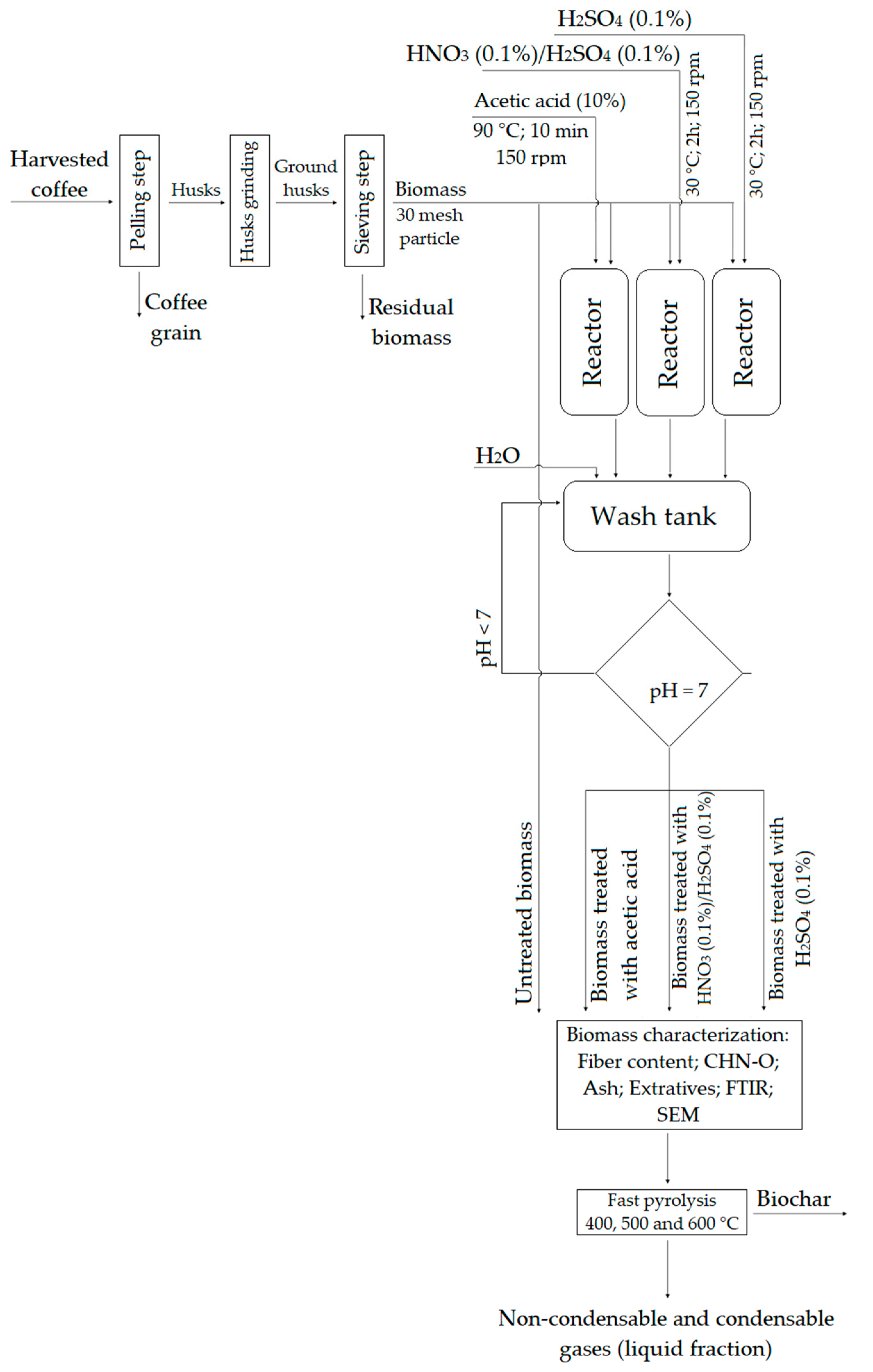
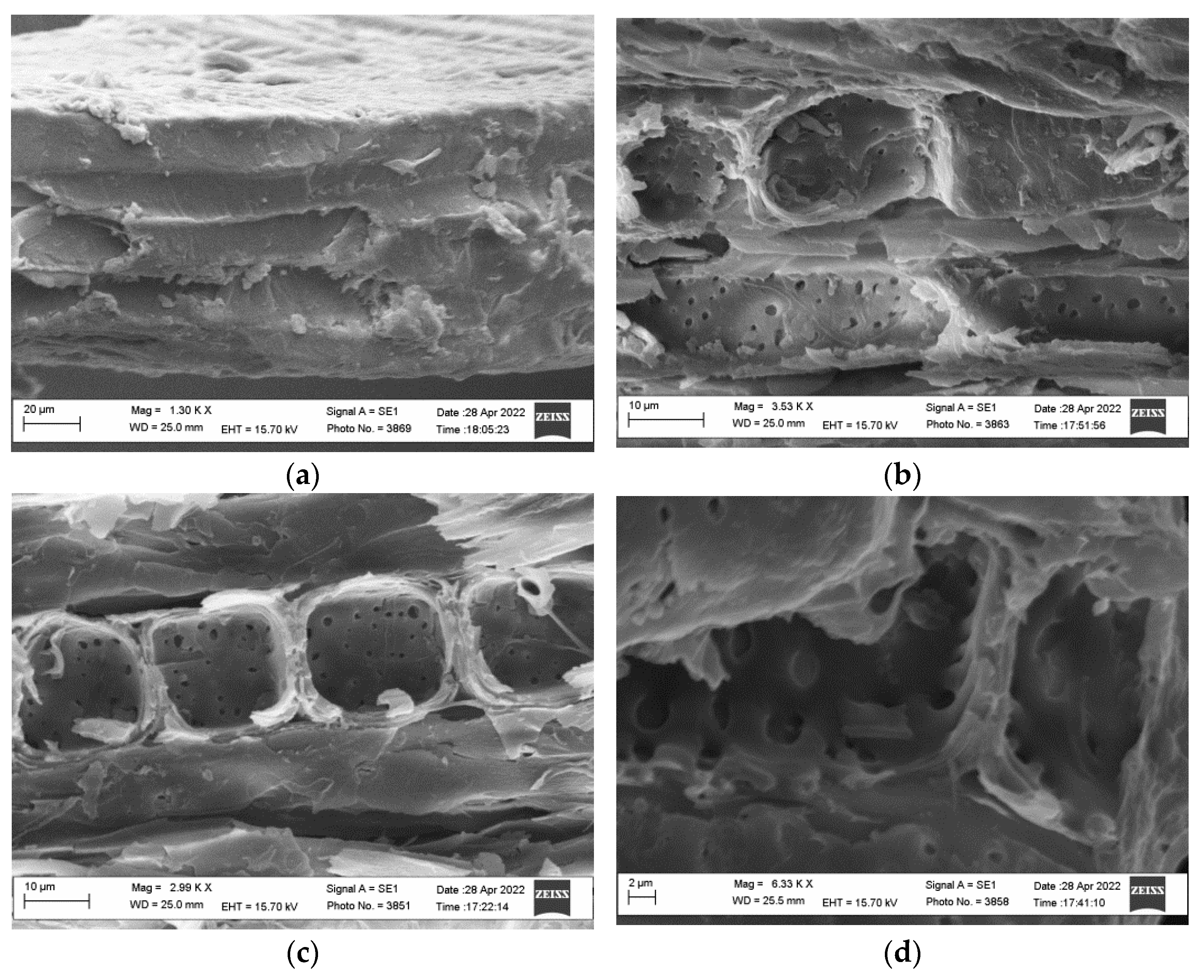

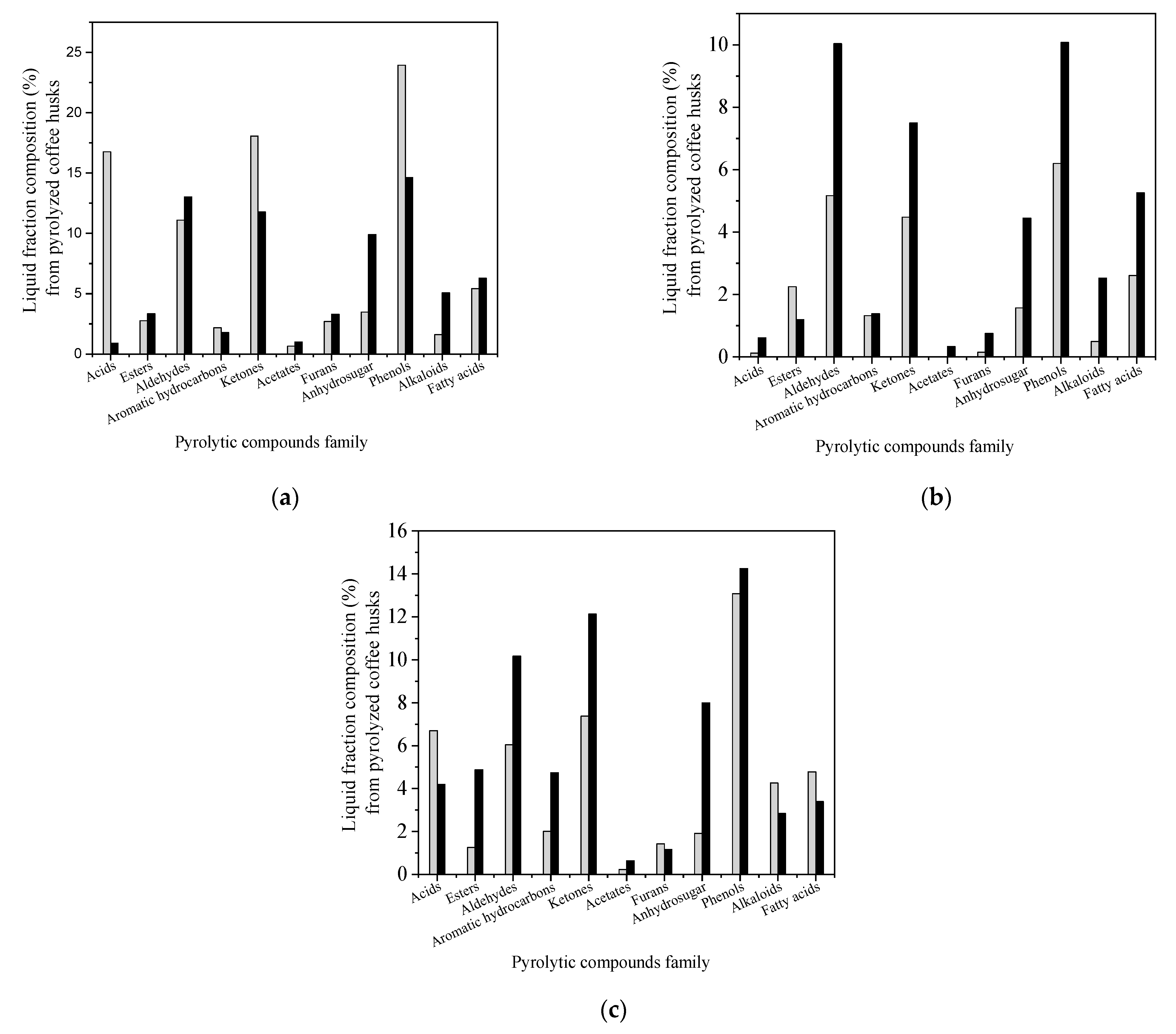
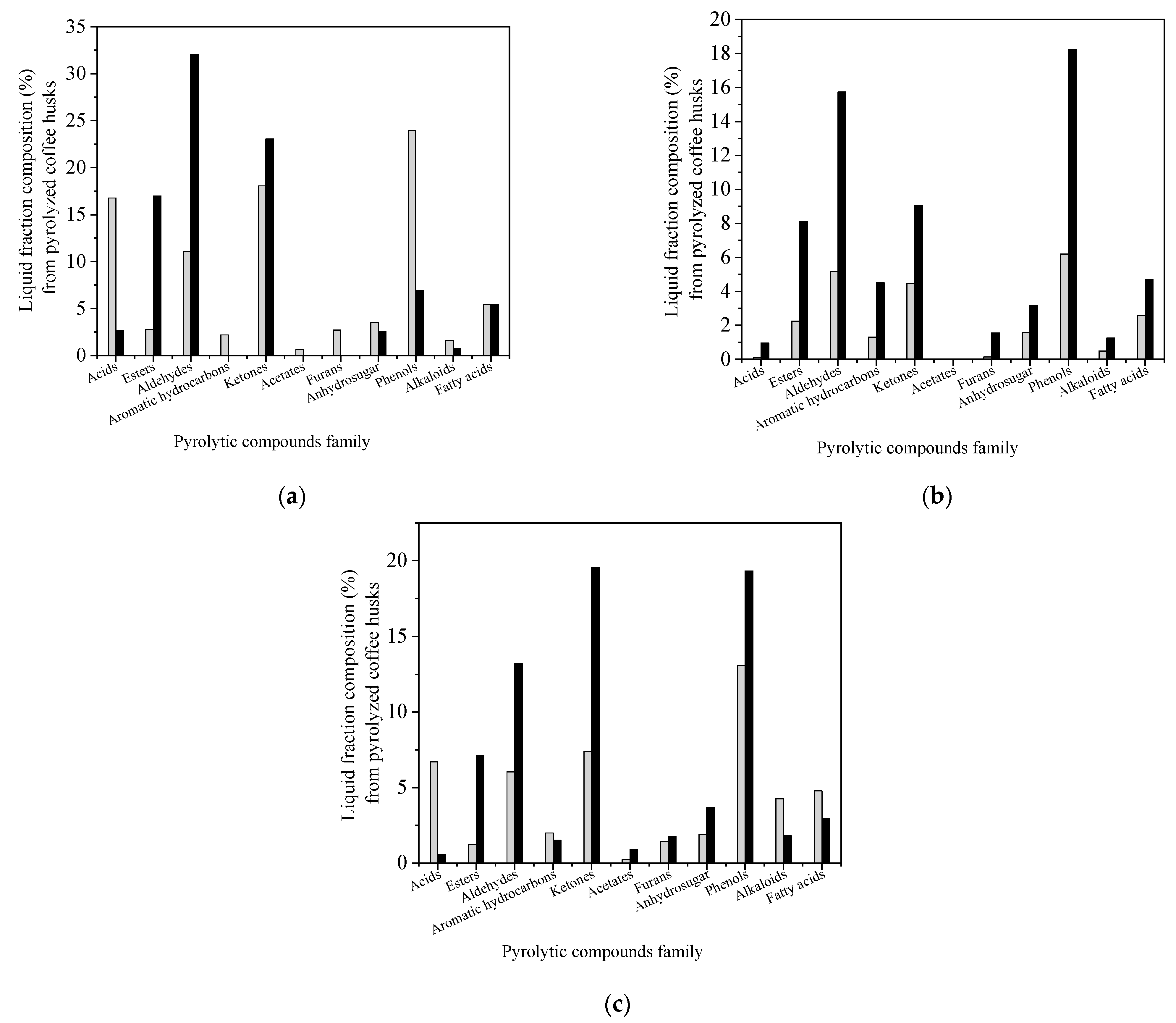
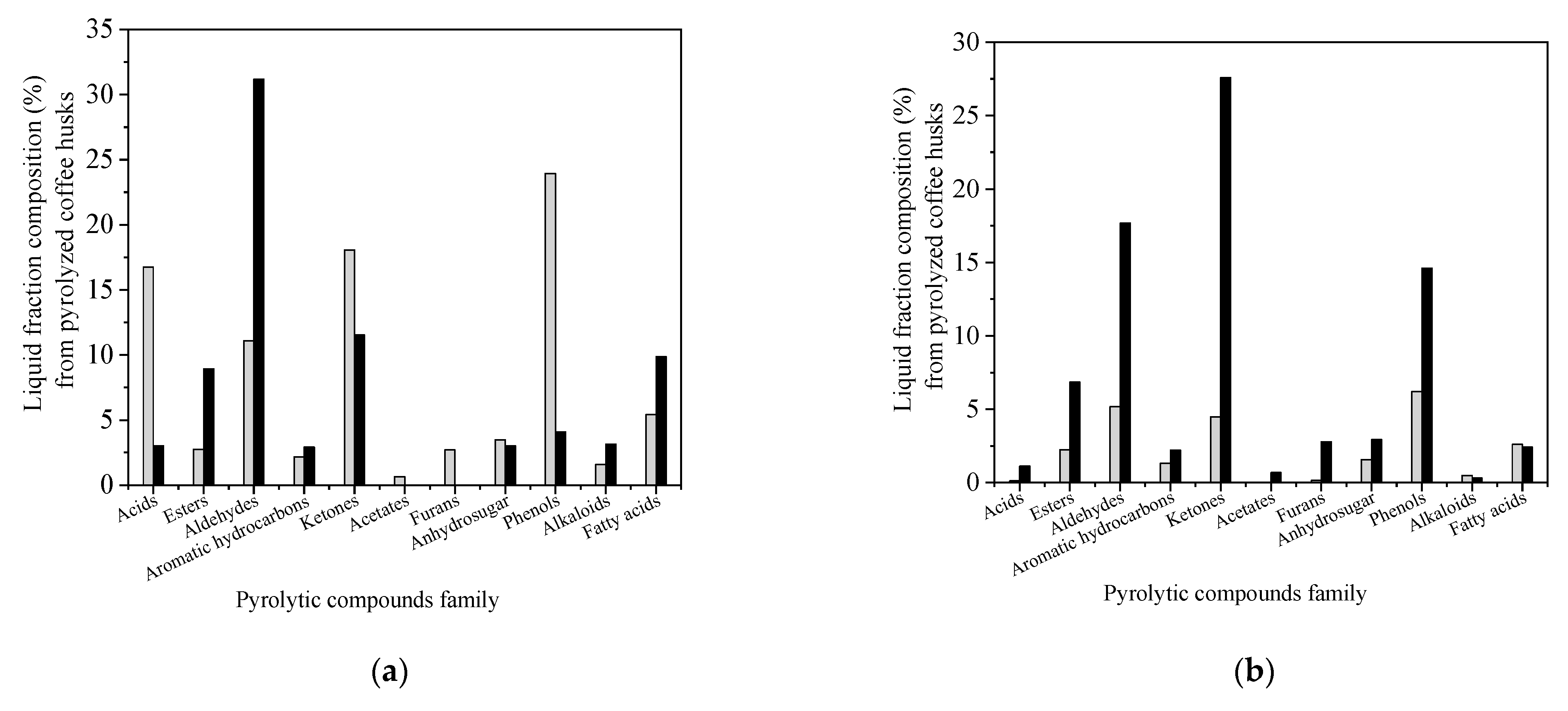
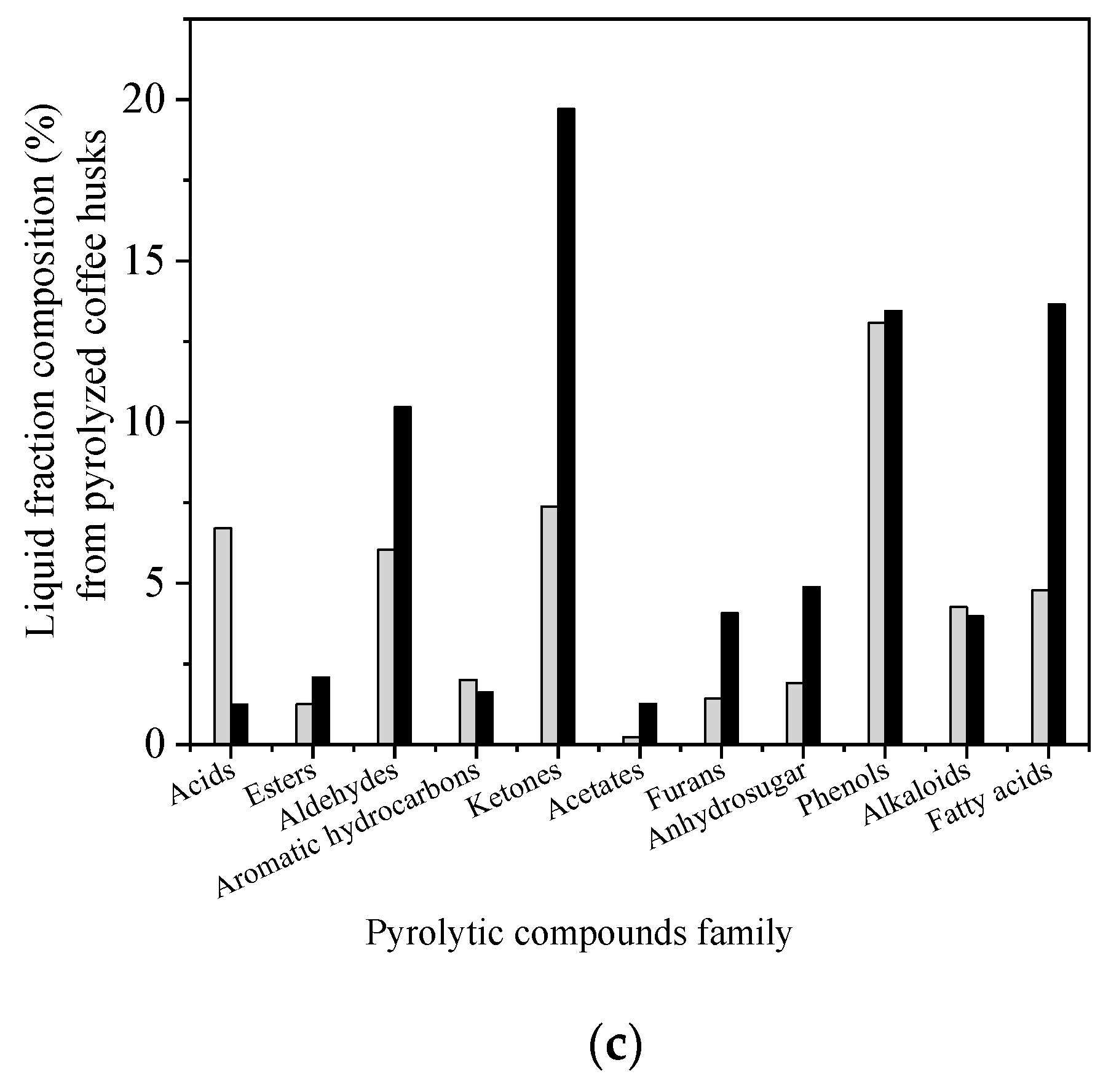
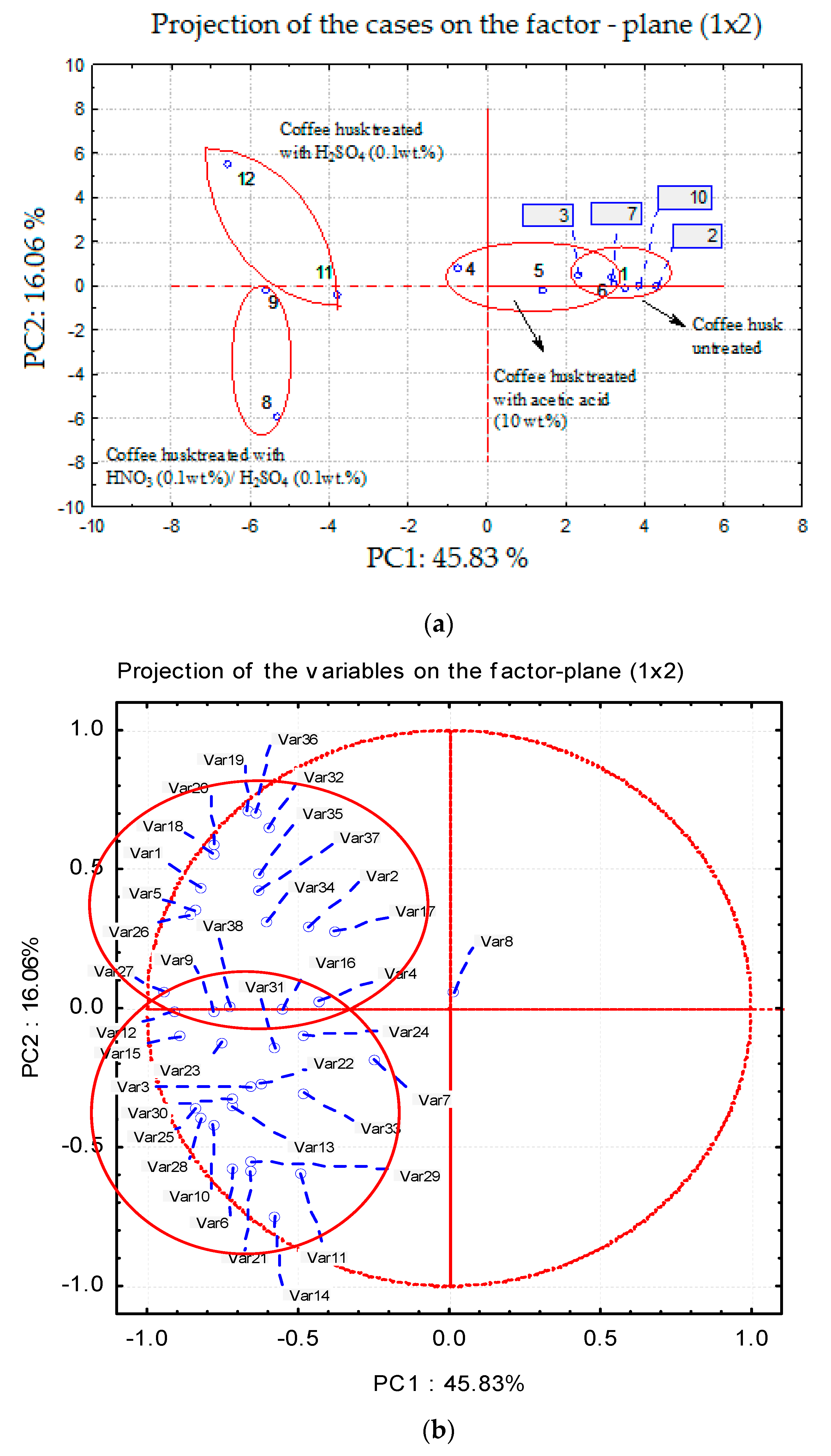
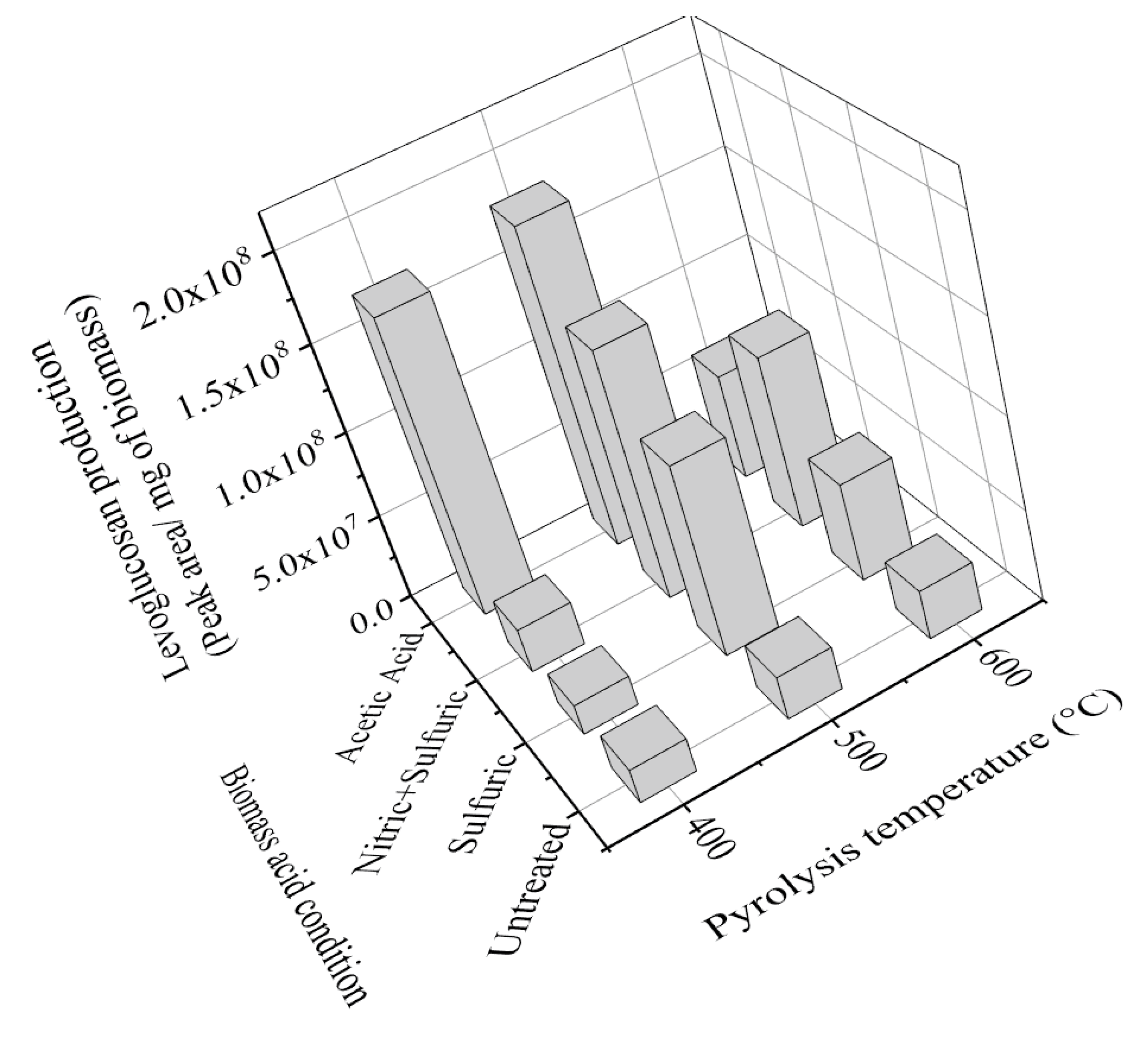
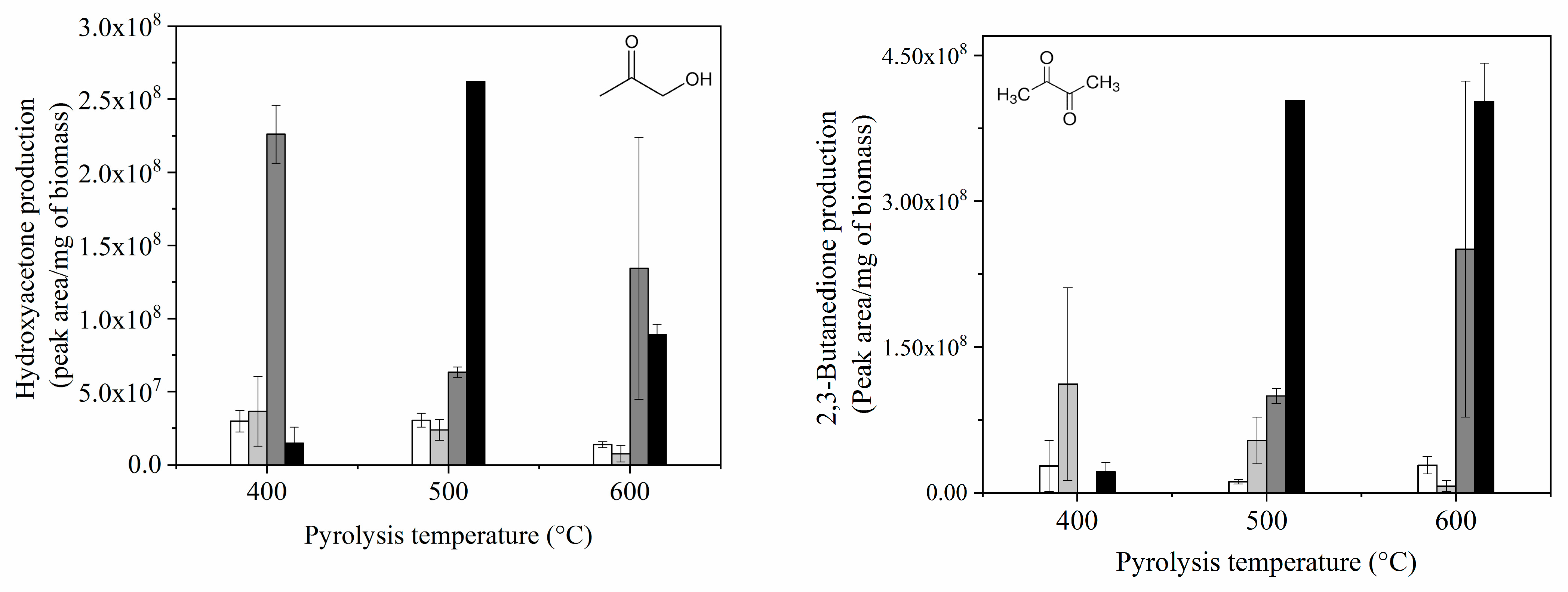
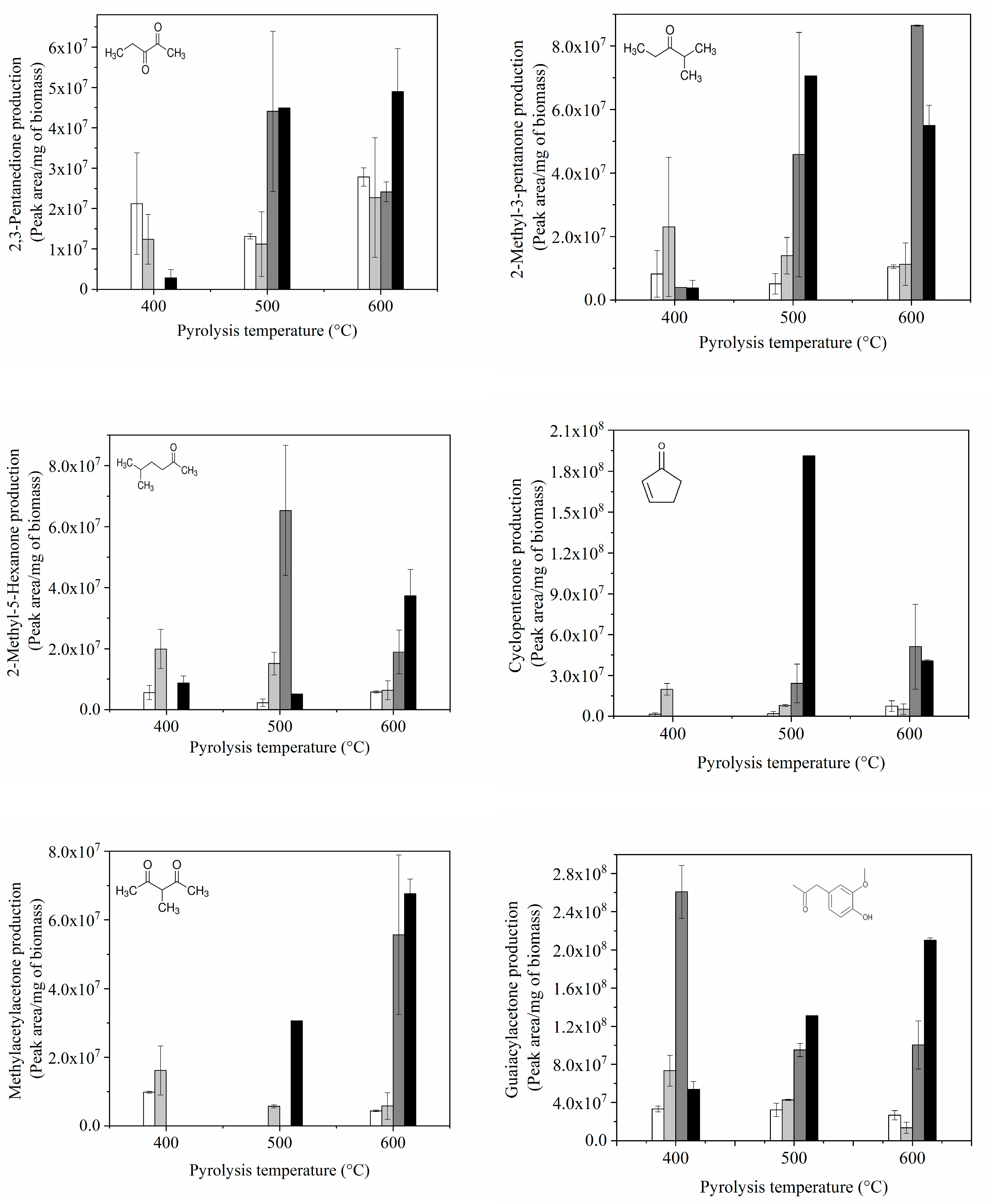
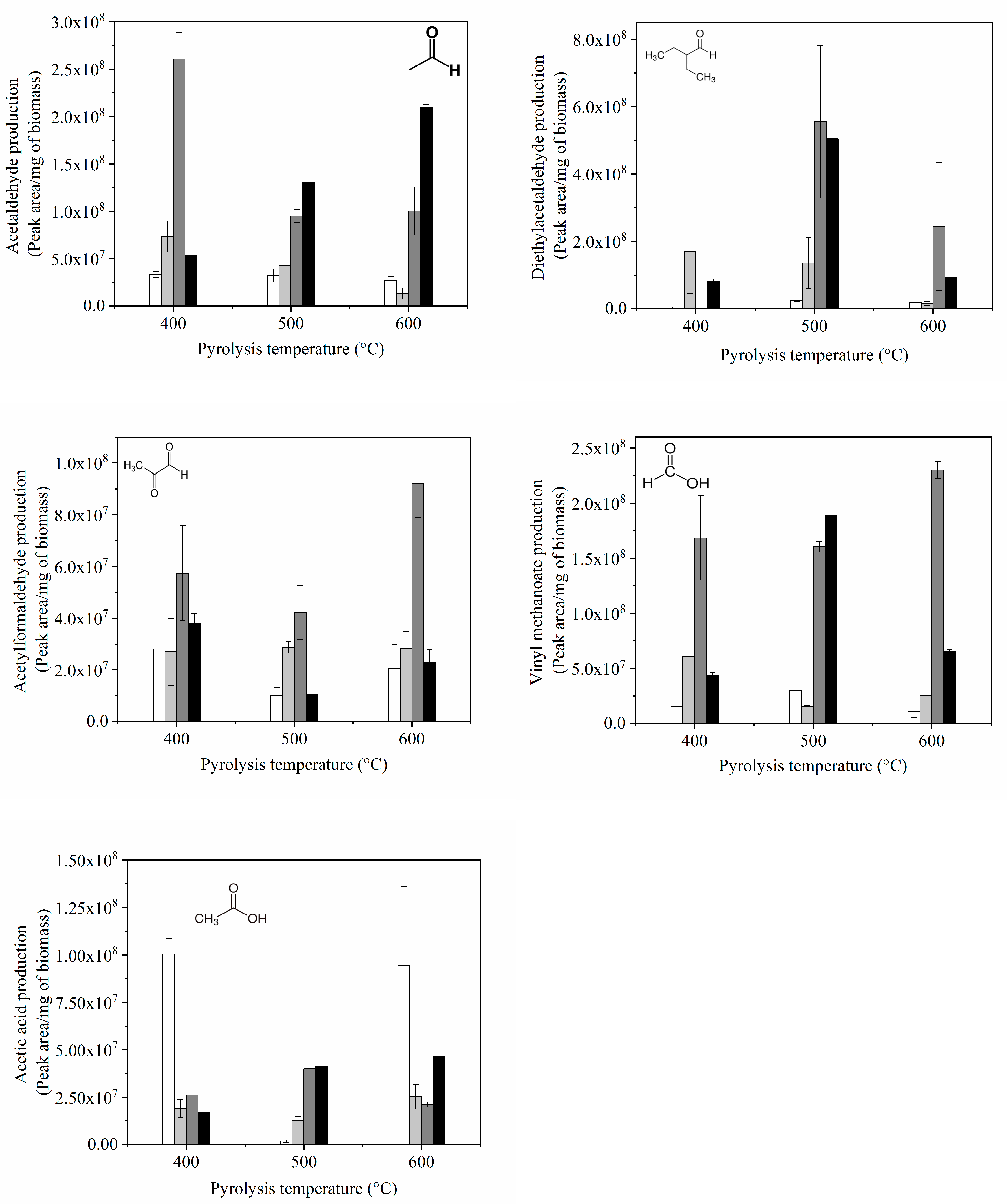
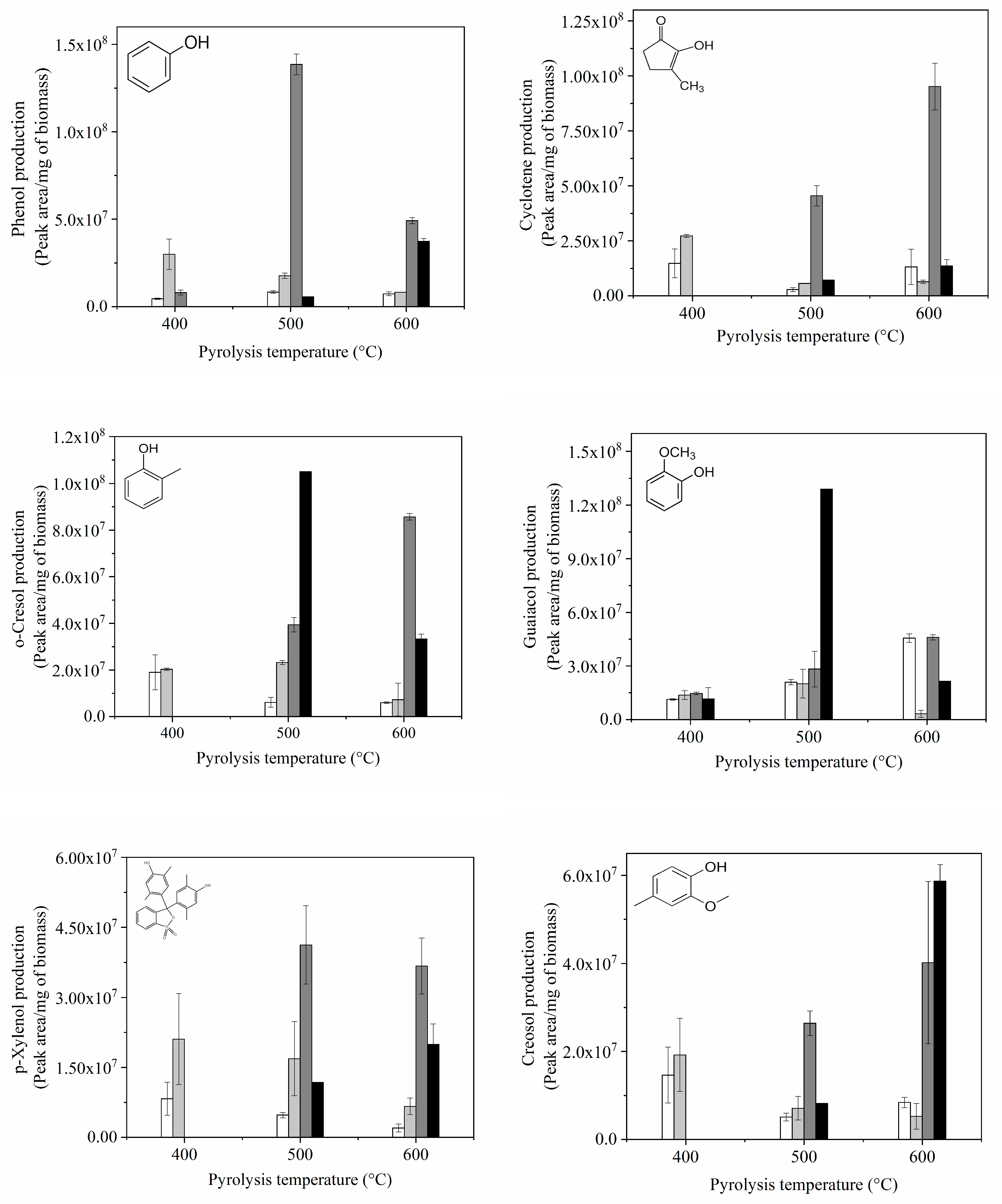

| Biomass Components | Composition (wt%) |
|---|---|
| Moisture | 14.56 ± 0.20 |
| Cellulose | 24.51 ± 0.18 |
| Hemicellulose | 13.42 ± 0.21 |
| Lignin | 11.47 ± 0.01 |
| Carbon | 43.08 ± 0.42 |
| Hydrogen | 4.53 ± 0.08 |
| Nitrogen | 4.02 ± 0.41 |
| * Oxygen | 48.12 ± 0.76 |
| Ash | 0.27 ± 0.02 |
| Extractives | 28.90 ± 0.01 |
| Principal Component | Variance (%) | Cumulative Variance (%) |
|---|---|---|
| PC1 | 45.82533 | 45.8253 |
| PC2 | 16.05843 | 61.8838 |
| PC3 | 13.41248 | 75.2962 |
| PC4 | 10.72452 | 86.0208 |
Disclaimer/Publisher’s Note: The statements, opinions and data contained in all publications are solely those of the individual author(s) and contributor(s) and not of MDPI and/or the editor(s). MDPI and/or the editor(s) disclaim responsibility for any injury to people or property resulting from any ideas, methods, instructions or products referred to in the content. |
© 2023 by the authors. Licensee MDPI, Basel, Switzerland. This article is an open access article distributed under the terms and conditions of the Creative Commons Attribution (CC BY) license (https://creativecommons.org/licenses/by/4.0/).
Share and Cite
Silveira Junior, E.G.; Perez, V.H.; de Paula, S.C.S.E.; Silveira, T.d.C.; Olivares, F.L.; Justo, O.R. Coffee Husks Valorization for Levoglucosan Production and Other Pyrolytic Products through Thermochemical Conversion by Fast Pyrolysis. Energies 2023, 16, 2835. https://doi.org/10.3390/en16062835
Silveira Junior EG, Perez VH, de Paula SCSE, Silveira TdC, Olivares FL, Justo OR. Coffee Husks Valorization for Levoglucosan Production and Other Pyrolytic Products through Thermochemical Conversion by Fast Pyrolysis. Energies. 2023; 16(6):2835. https://doi.org/10.3390/en16062835
Chicago/Turabian StyleSilveira Junior, Euripedes Garcia, Victor Haber Perez, Solciaray Cardoso Soares Estefan de Paula, Thays da Costa Silveira, Fabio Lopes Olivares, and Oselys Rodriguez Justo. 2023. "Coffee Husks Valorization for Levoglucosan Production and Other Pyrolytic Products through Thermochemical Conversion by Fast Pyrolysis" Energies 16, no. 6: 2835. https://doi.org/10.3390/en16062835
APA StyleSilveira Junior, E. G., Perez, V. H., de Paula, S. C. S. E., Silveira, T. d. C., Olivares, F. L., & Justo, O. R. (2023). Coffee Husks Valorization for Levoglucosan Production and Other Pyrolytic Products through Thermochemical Conversion by Fast Pyrolysis. Energies, 16(6), 2835. https://doi.org/10.3390/en16062835






